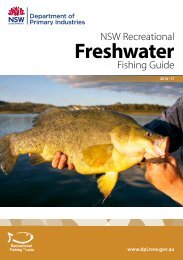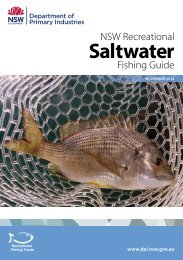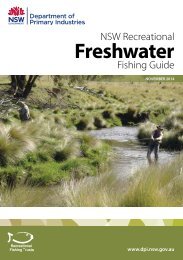freshwater-recreational-fishing-guide-2018-19
You also want an ePaper? Increase the reach of your titles
YUMPU automatically turns print PDFs into web optimized ePapers that Google loves.
13 How to use circle hooks<br />
Circle hooks have been shown to increase<br />
the survival of angler released fish. With their<br />
success already proven for many game fish<br />
species, the hooks are now used increasingly<br />
for many other common <strong>recreational</strong> species<br />
including Australian Bass, Golden Perch<br />
and Murray Cod. Circle hooks bring about<br />
many benefits for anglers, but they do<br />
require a few minor changes to your normal<br />
<strong>fishing</strong> techniques.<br />
■■<br />
Do not bury your hook (particularly with<br />
tough baits), lightly hook the bait so that<br />
the point and barb are exposed.<br />
■■<br />
When using soft baits like cheese or bread<br />
it is not so important to expose the hook as<br />
fish will crush the bait during the bite and<br />
become hooked.<br />
■■<br />
Do not strike at the fish, allow the fish time<br />
to take the bait into its mouth and then<br />
apply slow and steady pressure to set the<br />
hook in the mouth area. The fish often<br />
hook themselves.<br />
■■<br />
Non-offset circle hooks are recommended<br />
for the best mouth-hooking results.<br />
■■<br />
Use a de-hooker or needle-nosed pliers to<br />
help with unhooking.<br />
NSW Recreational Freshwater Fishing Guide Responsible <strong>fishing</strong><br />
Barotrauma<br />
Fish may suffer from barotrauma injuries when<br />
they are caught from deep water. Barotrauma<br />
occurs as a result of the expansion of gases in<br />
the swim bladder and other organs as the fish<br />
are not able to adjust to the rapid decrease in<br />
water pressure when they are pulled towards<br />
the surface.<br />
Returning the fish to capture depth is crucial<br />
in maximising the post-release survival of<br />
barotrauma-affected fish.<br />
■■<br />
Release your fish quickly with minimal time<br />
out of water. This provides the fish with a<br />
good chance to return to depth without<br />
any treatment.<br />
■■<br />
If the fish is displaying barotrauma<br />
symptoms and unable to swim down:<br />
■■<br />
■■<br />
Use a release weight to help return the<br />
fish to depth.<br />
If no other option is available, vent the<br />
fish to release the expanded gases.<br />
This technique requires considerable<br />
experience to carry out successfully<br />
without inadvertently damaging<br />
internal organs as the size and location<br />
of the swim bladder varies from species<br />
to species.<br />
Steps on how to make your own release<br />
weight are available under catch and release<br />
<strong>fishing</strong> at www.dpi.nsw.gov.au/fisheries<br />
DIY release weight<br />
Note barbless hook, cable ties and small screw<br />
to secure hook to sinker.<br />
More information on these techniques is<br />
available under best practice at:<br />
www.rec<strong>fishing</strong>research.org/category/practices








